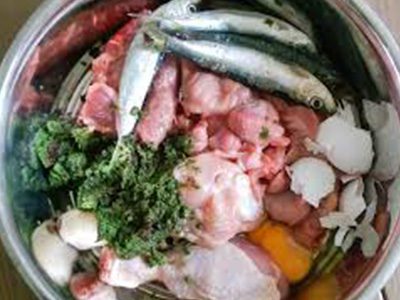
January 9th, 2018, by Ryan O’Quinn
The pet industry is booming. With growth in 2017 almost $3 billion higher than in the previous year alone, it’s an industry that continues to grow year over year. Just look at the statistics!
Inside industries with such steady growth, trends are bound to emerge — specifically the trend of raw feeding. But, is it a trend or something more likely here to stay? I’ll discuss some of the pros and cons and let you decide what’s best for you and your dog.
An idea proposed by Australian veterinarian Ian Billinghurst in 1993, the raw diet is pretty much exactly what it sounds like: whole, natural, uncooked foods. A common acronym is BARF, which can stand for either Biologically Appropriate Raw Food or Bones and Raw Food, ironically.
A raw dog food diet typically consists of:
– Muscle meat, often still on the bone
– Bones, either whole or ground
– Organ meats such as livers and kidneys
– Raw eggs
– Vegetables like broccoli, spinach, and celery
– Apples or other fruit
– Some dairy, such as yogurt
Statistics for Raw Feeding for Dogs
This new trend is growing in popularity but still remains controversial. One thing’s for sure: raw food diets are big business in America with sales of raw and raw alternative dog food more than doubling in just four years: from $117 million to $393 million in 2016.
Billinghurst suggested that adult dogs would thrive on an evolutionary diet based on what canines ate before they became domesticated: raw, meaty bones and vegetables. Grain-based commercial pet foods, he contended, were harmful to a dog’s health.
Conversely, many mainstream veterinarians disagree, as does the FDA. The risks of raw diets have been documented in several studies published in veterinary journals.
Right now, reports of health benefits and/or detriments are mainly anecdotal, and large-scale statistics are still probably several years away.
The Pros and Cons
Here we’ll list some the benefits and risks associated with a raw dog food diet.
Pros of a raw food diet include:
-Safety: You know exactly what ingredients your dog’s eating, so there’s no need to worry about commercial-food recalls.
-All-Natural: If you’re concerned about preservatives in commercial food, then a raw diet might be a good alternative.
-Your Dog Has Unique Dietary Needs: If your dog is allergic to or has adverse physical reactions as a result of eating certain ingredients in commercial foods, a raw food diet may be the solution.
Other benefits touted by raw feeding advocates may include things such as shinier coats, healthier skin, cleaner teeth, higher energy levels and smaller stools (you may notice the poop can sometimes be white in color and can become powder-like or crumble easily upon touch or contact).
Cons of a raw food diet include:
-Possible Contaminants: Raw diets can put dogs at risk for Salmonella, Campylobacter, E-coli, and other harmful diseases. Humans are also at risk of acquiring these diseases if proper washing and handling instructions are not met sufficiently.
-Safety Risks: Dogs can choke, chip their teeth, or suffer intestinal blockage or organ perforations from chewing on and eating bones. Additionally, dogs have a hard time digesting raw vegetables, so veggies should be blanched and ground, which requires more work
-Convenience: Or lack thereof — a raw food diet for dogs can be expensive and it’s definitely time-consuming putting together multiple meals per day. Feeding then gets more difficult or complicated if you’re traveling with your dog or left him behind with a sitter. (However, some grocery chains are implementing raw dog food sections in their stores to make shopping for certain items more convenient, as well as to cash in on the trend.)
What should you do?
Before changing or altering your dog’s diet, especially if you’re considering making an abrupt move from kibble to raw, it’s always smart to consult with your veterinarian beforehand. Your dog may have certain health conditions that make a drastic change in diet prohibitive. Be sure to also do extensive research on the internet before talking with your vet, so you can make an informed decision about what goes in your fur babie’s bowl.








